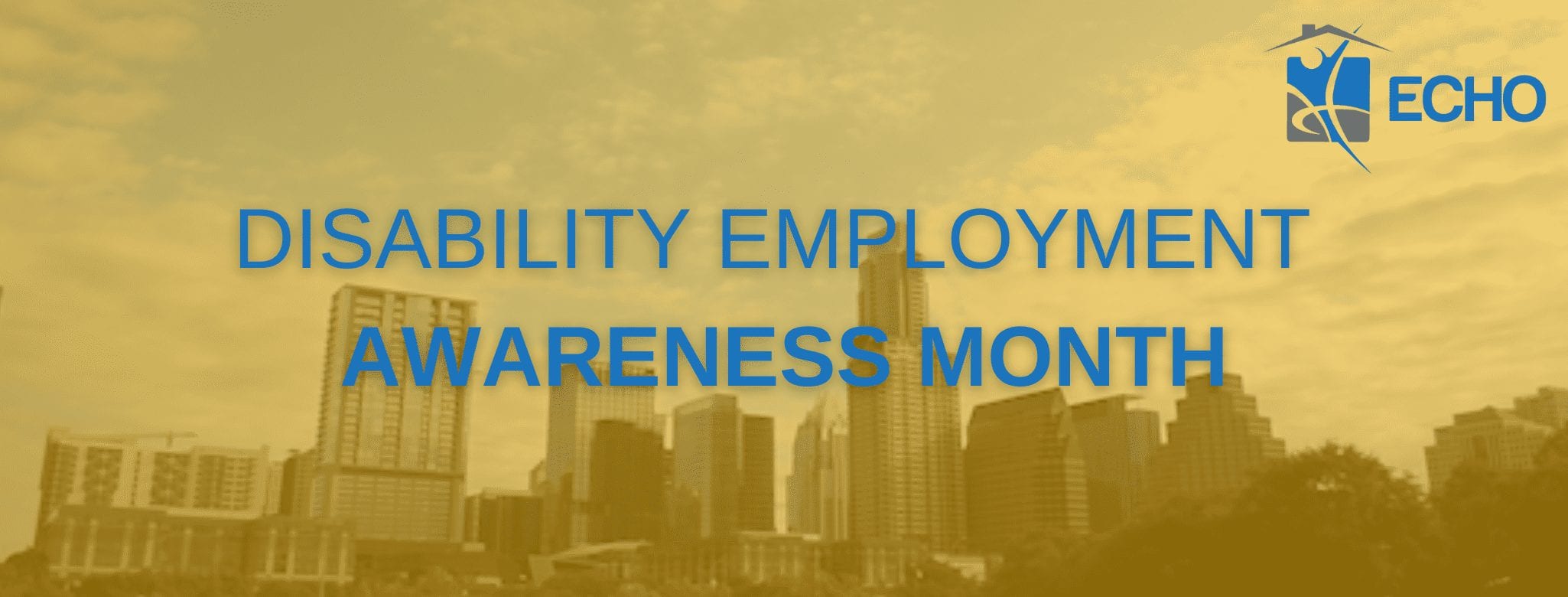The intersection of disabilities, employment, and homelessness in Austin
AUSTIN, Texas (October 29, 2020) — People with disabilities in Austin and Travis County face significant hurdles to gainful employment; many of these hurdles are reflected in our homeless response system.
October marks the 75th observance of Disability Employment Awareness Month. This year also marks the 30th anniversary of the passage of the Americans with Disabilities Act (ADA). ECHO is highlighting the hurdles people with disabilities face in the workplace to examine lessons we can learn to help people with disabilities improve their lives and avoid experiencing homelessness as a result of struggles they face in employment.
There are three key points to understand about the intersection of disabilities, employment and homelessness in our community:
- People with disabilities are employed at much lower rates than people without disabilities.
- People with disabilities face additional barriers to employment, and employers are often protected if they are wary of hiring or making accommodations for people with disabilities, regardless of provisions in the ADA.
- More than half of Austin’s population of people experiencing homelessness report having at least one disability, and poverty – often a result of unemployment or underemployment – is a common cause of homelessness.
Disabilities and employment
There are two factors that lead to lower employment rates among people with disabilities: a lower rate of labor force participation and a higher unemployment rate among those in the labor force.
The unemployment rate for people with disabilities, among those actively looking for work between the ages of 16 and 64, is 7.3% in Austin/Travis County, nearly double the unemployment rate (3.9%) among those without a disability.
Only about half (52.5%) of people with disabilities in that age range, though, are actively participating in the labor force, or looking for work. Compare that to 80.5%, or 4-in-5 people without disabilities. Both the percentage of people with disabilities actively looking for work and the percentage of those job-seekers who are employed are considerably lower than their counterparts without disabilities.
The next observation helps to understand why.
Barriers to employment
Despite the progress made in the last 30 years thanks to the landmark ADA, people with disabilities still face additional barriers to employment that people without disabilities simply do not.
Evidence suggests employers still harbor implicit biases toward people with disabilities. Those biases can convince employers a person with a disability might not be able to perform a specific job, regardless of whether or not that’s true (Bonaccio et. al, 2020).
Concerns about the high cost of accommodating employees with disabilities are similarly unsupported by evidence, but they persist among many employers (Kaye et. al, 2011). Even asking for an accommodation on the job can be intimidating and uncomfortable for an employee with a disability, and employers are legally allowed to deny those requests in many cases.
Finally, the ADA does not apply to companies with fewer than 15 employees, and it does not necessarily prevent a person with a disability from being denied or terminated from employment opportunities due to the effects their disability may have on their ability to meet the essential functions of the job.
Those barriers, and the resulting labor force implications, lead to financial hardships for people with disabilities. Austin/Travis County’s homeless response system sees the effects.
Disabilities and homelessness
A person experiencing homelessness is much more likely to have at least one disability than a housed person in Austin/Travis County.
In the overall population, 6.1% of people in Travis County under the age of 65 have a disability. Among people served by the homeless response system, that number is 55.6%. The most common disabilities for people with disabilities and experiencing homelessness are mental health issues (69.5%), chronic health conditions (50.3%), and physical disabilities (46.6%).
Some people experiencing homelessness qualify for and receive Social Security Disability Insurance (SSDI) payments from the federal government, but those benefits are only available for people who were able to work for a certain period of time before losing their jobs. Applying for SSDI benefits is also a lengthy, complicated process for a housed person with access to vital documents and records, let alone for a person living unsheltered in our community.
Additionally, SSDI benefits averaged $1,259 per month in September 2020. The fair market rent for a one-bedroom apartment in Austin/Travis County this year is $1,134.
Poverty is a key driver of homelessness in Austin/Travis County. People experiencing homelessness and seeking housing programs make just 15% of Austin’s average income ($13,175 a year), and 52% of them have no income at all.
What does all this tell us?
It is difficult to draw causal links between all these data points, but a few things are clear.
People with disabilities are far less likely to be employed and still face discrimination in the workplace, making it more difficult to keep a job long enough to qualify for federal disability benefits that are often not enough to remain stably housed in the first place. People experiencing homelessness are much more likely to have disabilities than people who are housed, which complicates necessary activities like seeing a doctor or navigating the city, and makes finding a job to climb out of homelessness that much harder.
These are issues we can solve. We can choose to strengthen protections in the ADA to prevent employers from acting on unfounded biases and financial concerns. We can choose to expand healthcare coverage to more people to ensure they can effectively manage their disabilities. We can choose to provide better benefits with lower barriers to people with disabilities who are unable to work. We can choose to invest in more Permanent Supportive Housing to provide homes for people who need wraparound services.
We can choose to end homelessness, for people with disabilities and for everyone.
Research for this post conducted by ECHO’s Research and Evaluation Team
Sources:
- U.S. Bureau of Labor Statistics
- Bonaccio, Silvia, Catherine Connelly, Ian Gellatly, Arif Jetha, and Kathleen Ginis. 2020. “The Participation of People with Disabilities in the Employment Cycle: Employer Concerns and Research Evidence.” Journal of Business and Psychology 35 (2): 135–58.
- Kaye, H. Stephen, Lita Jans, and Erica Jones. 2011. “Why Don’t Employers Hire and Retain Workers with Disabilities?” Journal of Occupational Rehabilitation 21 (4): 526–36.
- Austin/Travis County Homeless Management Information System (HMIS) database
- U.S. Census Bureau
- U.S. Social Security Administration


